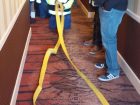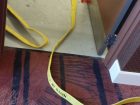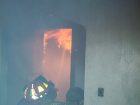
Features
Training
Back to Basics: June 2015
Standpipe systems are designed to supply firefighters with water at any height and at a constant flow and pressure.
May 22, 2015
By Mark van der Feyst
This two-part lesson is based on highrise training I helped conduct in February for the Hogansburg Akwesasne Volunteer Fire Department in New York at a casino in its response area. We had complete access to the fourth floor and a hotel room in the casino to practise making the stretch.
As a side note, it is always beneficial to access opportunities for training. It is up to the fire department to approach highrise building owners or managers and try to establish working/training relationships. Be proactive and see what may be available.
A great time to approach owners or managers is when a highrise is under construction and does not have any interior finishes that would be damaged by water flow. In order for the Hogansburg Akwesasne department volunteers to train at the casino, the hoseline could not be charged and structural firefighting gear could not be worn inside.
The May edition of Back to Basics, part 1 of this lesson, explained the engine-company task of securing the standpipe water source inside a highrise for suppression. It is important that members of the engine company can smoothly and easily hook up to the standpipe.
Once firefighters have secured the standpipe and hose, they can advance past the stairwell door and into the room of origin.
Before advancing the hoseline from the protected stairwell into the hallway, make sure that the door has been felt for heat. By the time members of the engine company climb to the fire floor, the fire may have spread out of the unit and into the hallway. If the fire is in the hallway it requires a more aggressive fire attack from the stairwell moving to the fire source.
The size of hoseline used for the operation dictates how aggressive the attack should be – if it is the standard 38-millimetre (1 1/2-inch) or 45-millimetre (1 3/4-inch) hoseline, the attack is limited. If the hoseline is a 65 millimetre (2 1/2-inch), then the attack will be much easier to handle based on the amount of water flowing. (Jeff Cowan details the argument for using the 65-millimetre (2 1/2-inch) hoseline for commercial buildings in the April edition of Canadian Firefighter.)
Once the stairwell door is felt for heat and it is safe to access the hallway, firefighters can open the door and advance the hoseline into the hallway. Photo 1 shows how the hose is advanced out the stairwell door and around the corner. The door can be either kept open with a door chock (as shown in the photo), or it can be free to close onto the charged hoseline. Some firefighters think the door should be kept open, other say it should be allowed to close. If the door is closed, it will help prevent smoke from
entering the stair shaft. Positive-pressure ventilation set up in the stair shaft would also help keep the smoke out.
Once in the hallway, firefighters should ensure there is enough hose available for advancement. Dedicate one firefighter to pulling hose out from the stair shaft and readying it for the stretch into the hallway and the unit. Because there is not enough space in the hallway to make large loops of hose, create a figure eight to avoid kinks by looping the hose onto itself (see photo 2).
The firefighter dedicated to pulling out hose then joins the firefighter operating the nozzle to help advance the hoseline down the hallway and into the unit.
Advancing into the unit is difficult work – it takes a lot of energy to pull and push the charged hose. Once at the unit’s door, the firefighter operating the nozzle again feels the door for heat and then slowly opens it to gauge the conditions inside the unit. If the conditions are dangerous, the door should be closed again to confine the fire while firefighters wait for extra resources and help to arrive.
When opening the door to the unit, remember to never expose yourself directly to the fire. Firefighters can use the wall or the door to shield themselves from the direct radiant heat. Photo 3 shows how firefighters apply a stream of water from a distance, providing there is adequate pressure and flow for the water to reach the target.
Maintaining a distance allows the team members to shield themselves from the heat while at the same time suppressing the fire and then advancing further into the unit.
Most highrise hotel rooms or apartments are not large, which means hose streams will adequately reach the opposite end, allowing firefighters to defend themselves.
STANDPIPE STEPS
- Secure the standpipe and hose.
- Feel stairwell door for heat to determine if the fire has spread into hallway.
- Advance hoseline from stairwell to hallway.
- Use a chock to keep the door open, or allow door to close on charged line.
- Ensure there is enough hose for advancement.
- Create a figure eight to prevent kinks.
- Advance hoseline to the unit of origin.
- Feel the door for heat and gauge conditions.
- Use the wall or door as a shield from radiant heat.
- Apply a stream of water from a safe distance.
Mark van der Feyst has been in the fire service since 1999 and is a full-time firefighter in Ontario. Mark teaches in Canada, the United States and India. He is a local-level suppression instructor for the Pennsylvania State Fire Academy and an instructor for the Justice Institute of BC. He is also the lead author of Pennwell’s Residential Fire Rescue book. Email mark at Mark@FireStarTraining.com
Print this page


